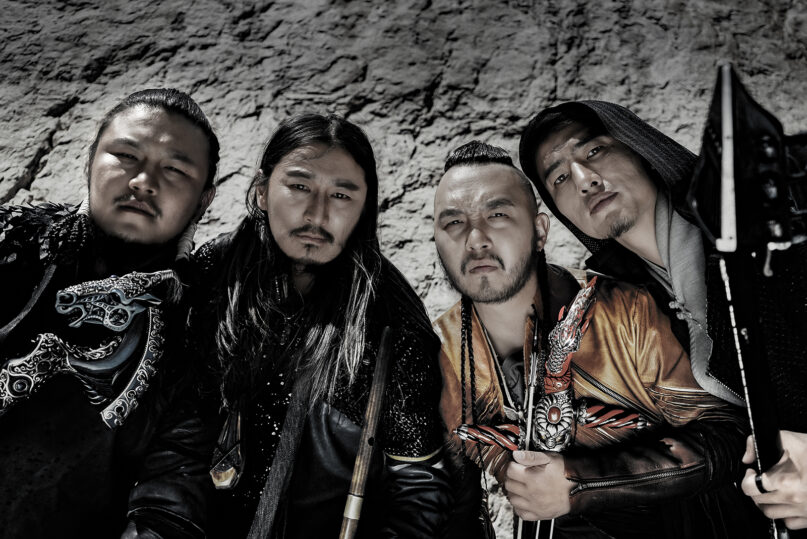(RNS) — An eight-man heavy metallic band from Mongolia often known as The Hu has finished what few thought might occur within the 21st century: Create a brand new style of folk-metal music. Decked out in black battle regalia out of the 13th century, they sing invocations to a Mongolian sky deity and odes to 13th century warlord Genghis Khan.
Not that anybody appears to essentially discover. At a current efficiency opening for heavy metallic superstars Iron Maiden on the Tacoma Dome in Washington state, the band’s lead singers, winging their lengthy black hair to the raucous beat, belt out their lyrics in a deep guttural drone-like fashion often known as throat singing. In Mongolian.
Their success — The Hu is the primary Mongolian band to high a Billboard chart (in 2019 they usually’ve been streamed 780 million instances on Spotify — arguably has little to do with their message, which incorporates ideas on battle, future and local weather change. It has all the pieces to do with their fashion, starting with their spectacular entrance below a black Mongolian battle banner and their wild-horse-steppe Mongolian vibe.
However underlying their Hun metallic demonstrativeness is a shamanist spirituality and their devotion to the chief embodiment of sky deity Tengri, a folks pantheism they share with some 5% of Mongolians.
About 50% of the populace is Tibetan Buddhist, 40% are atheist (thanks little question to 70 years of Communism below the Soviets), with the remaining 10% evangelical Christians, Tengrists/shamans, Muslims, Mormons and a sliver of Catholics.
Within the Mongolian custom, shamans use rituals and trance states to speak with the lifeless or non secular beings. Though the gamers don’t declare to be shamans, the pounding “Shoog, Shoog,” one in every of their early songs, is the shamanic name to ancestral spirits.

The Hu. (Photograph by E. Altankhuyag)
Entrance man Temuulen “Temka” Naranbaatar, 34, who performs an electrical “tovshuur,” a gold-embossed three-stringed lute, mentioned he was on a non secular search in regards to the time he joined up with the band in 2016. “I used to be not a lot of a believer if you’ll,” he mentioned by a translator in a pre-show interview in Tacoma. “I used to be curious what the Christian church needed to provide and simply visited with my mates a few instances. However it was nothing greater than that.”
His musical journey, nonetheless, introduced Temka involved with songwriter and producer Bayarmagnai Dashdondog, a veteran within the Mongolian pop music trade. Temka, then 26, and the opposite younger males who would kind The Hu, clicked with the character faith described in Dashdondog’s lyrics.
“The traditions of Tengerism are very interconnected to our tradition, to our nomadic life,” Temka mentioned. “The nomadic lifestyle additionally impacts how your mind works … that’s how my mind works; that’s the reason I’m who I’m as we speak.”
Dashdondog, the mastermind behind the group’s rise, is in his 50s. Band members have described him as a person who has traveled again to his roots in Mongolia’s western Khovd province to write down songs for his father and ancestors. His compositions for The Hu are aided by “my dad and mom and my ancestors,” he instructed an Australian publication in 2022.
Songs resembling “That is the Mongol” and “Upright Destined Mongol” laud the “glory of our ancestors” and describe “ancestors who thrived worshipping the sacred mountain Khaldun,” believed to be Genghis Khan’s birthplace.
“For us, Tengerism is a perception system that our ancestors are trying over us, nevertheless it doesn’t essentially imply we have now a sure Bible or another faith or a Quran,” mentioned Temka. “It’s a perception that … we’re guided by our ancestor spirits.”
In mid-2018, Dashdondog despatched his proteges on a 3,100-mile trek by western Mongolia, the place they taped Yuve, Yuve, Yu, a surprising video crammed with dramatic landscapes.
It was a smash hit. The world couldn’t get sufficient of what seemed like 4 Huns in black leather-based or brown tunics, or “deels,” interwoven with metallic studs, buckles, chains, bones and feathers. A drone captures them striding about in upturned conventional “gutal” boots, hair braids flying, and hoisting all method of unique stringed devices whereas singing about prophecy and the second coming of Genghis Khan.
That was adopted by The Wolf Totem, a bestselling video showcasing a person on a horse carrying a black Mongolian battle banner, adopted by a posse of stern leather-clad males on bikes doing battle chants. YouTube views soared into the tens of millions.
Dashdondog’s affect clearly looms massive, however the precise non secular composition of the band is considerably imprecise. When The Hu shaped in 2016, two of the 4 further members, Temka mentioned, had Christian backgrounds. Guitarist Jambaldorj “Jamba” Ayush, he mentioned, used to attend a Christian college; Odbayar “Odko” Gantumur was a drummer for a church. Enkhsaikhan “Enkush” Batjargal, a entrance band member who performs a box-shaped horse fiddle often known as the “morin khuur,” grew up Buddhist, Temka added.
A dive into Odko’s Fb web page revealed Christian-friendly posts in 2012, resembling music from the Australian band Hillsong and a publish that reads “With God, all issues are attainable.”
Temka swears all of it works in relation to making music. “We’ve a really excessive tolerance by way of non secular variations,” he mentioned. “All of us match our vitality collectively.”
When requested what this seems to be like within the day-to-day lifetime of the band, Temka mentioned the group gathers about 10 minutes earlier than their present to name down vitality and shout out the phrase “hu,” which “helps us be in sync on stage all collectively.”
“We do name on our ancestors in that chant collectively,” he mentioned. “There are eight folks. We attempt to match our energies and attempt to convey them on stage. That helps us give the vitality to our viewers and helps them perceive the that means of the phrases with out having to translate the phrases.”












